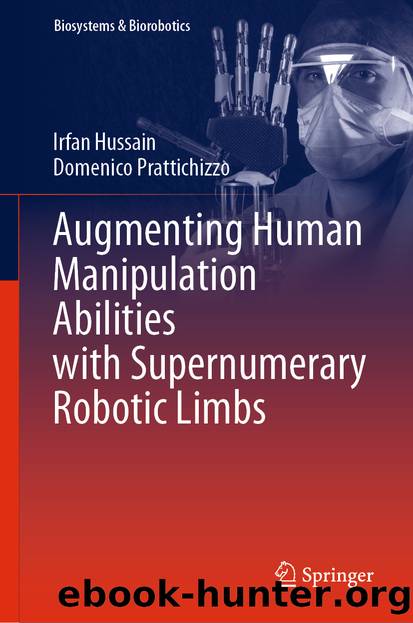Augmenting Human Manipulation Abilities with Supernumerary Robotic Limbs by Irfan Hussain & Domenico Prattichizzo

Author:Irfan Hussain & Domenico Prattichizzo
Language: eng
Format: epub
ISBN: 9783030520021
Publisher: Springer International Publishing
4.6 Conclusion
This chapter presents design, analysis, manufacturing, experimental characterization and evaluation of two prototypes of soft robotic extra fingers that can be used as grasp compensatory robotic devices for hemiparetic upper limb. An approach is illustrated to to model the kinematics and the passive stiffness of flexible grippers and its realization in order to follow a desired trajectory for the finger. It explored the role of stiffness in grasping performance and demonstrated a novel method which is applicable to any tendon-driven, underactuated and passively compliant hand. The grasping performance of such grippers mainly depends on their intrinsic characteristics, e.g., passive joint compliance, instead of relying on active control for compliance used in complex manipulators. Firstly, a procedure to determine suitable joints stiffness is defined and then a possible realization in robotics fingers hardware structure is proposed. Without any loss of generality, It proposes a modular approach to define robotic hands. In most of the solutions existing in the literature, the hand is composed of a series of identical fingers, and the modularity is exploited at the finger level while we propose each phalanx built with same modules, i.e., a flexible joint and a rigid link. The model is built using theory of mechanics of tendon-driven hands coupled with beam theory. The feasibility of the approach was demonstrated through a framework composed of both simulations and exploitation of model in the realization of the Soft-SixthFinger. The experiments revealed that modelling joint stiffness and its realization using the proposed method improved the grasping performance and shape adaptation to a wider set of objects. Obviously, the presented approach can also reduce the manufacturing iterations needed to optimize the joints stiffness. Moreover, the proposed mathematical framework can also be used in continuum hands modelling (e.g., RBO hand) by further discretize the joints and links distribution. The devices are developed using rapid prototyping 3D printer and moulding techniques. the devices are tested with chronic stroke patients through qualitative experiments based on ADL.
Download
This site does not store any files on its server. We only index and link to content provided by other sites. Please contact the content providers to delete copyright contents if any and email us, we'll remove relevant links or contents immediately.
Algorithms of the Intelligent Web by Haralambos Marmanis;Dmitry Babenko(8519)
Test-Driven Development with Java by Alan Mellor(7356)
Data Augmentation with Python by Duc Haba(7254)
Principles of Data Fabric by Sonia Mezzetta(6999)
Learn Blender Simulations the Right Way by Stephen Pearson(6935)
Microservices with Spring Boot 3 and Spring Cloud by Magnus Larsson(6769)
RPA Solution Architect's Handbook by Sachin Sahgal(6170)
Hadoop in Practice by Alex Holmes(6028)
The Infinite Retina by Robert Scoble Irena Cronin(5874)
Jquery UI in Action : Master the concepts Of Jquery UI: A Step By Step Approach by ANMOL GOYAL(5869)
Big Data Analysis with Python by Ivan Marin(5695)
Life 3.0: Being Human in the Age of Artificial Intelligence by Tegmark Max(5399)
Pretrain Vision and Large Language Models in Python by Emily Webber(4656)
Infrastructure as Code for Beginners by Russ McKendrick(4441)
WordPress Plugin Development Cookbook by Yannick Lefebvre(4170)
Functional Programming in JavaScript by Mantyla Dan(4121)
The Age of Surveillance Capitalism by Shoshana Zuboff(4112)
Embracing Microservices Design by Ovais Mehboob Ahmed Khan Nabil Siddiqui and Timothy Oleson(3959)
Applied Machine Learning for Healthcare and Life Sciences Using AWS by Ujjwal Ratan(3933)
